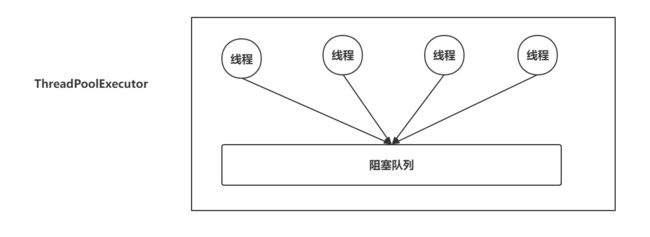Executors工具类
concurrent包提供了Executors工具类,jdk基于Executors提供了很多种线程池。
public class Executors {
/**
* Creates a thread pool that reuses a fixed number of threads
*/
public static ExecutorService newFixedThreadPool(int nThreads) {
return new ThreadPoolExecutor(nThreads, nThreads,
0L, TimeUnit.MILLISECONDS,
new LinkedBlockingQueue<Runnable>());
}
/**
* Creates a thread pool that maintains enough threads to support
*/
public static ExecutorService newWorkStealingPool(int parallelism) {
return new ForkJoinPool
(parallelism,
ForkJoinPool.defaultForkJoinWorkerThreadFactory,
null, true);
}
/**
* Creates a work-stealing thread pool using all
*/
public static ExecutorService newWorkStealingPool() {
return new ForkJoinPool
(Runtime.getRuntime().availableProcessors(),
ForkJoinPool.defaultForkJoinWorkerThreadFactory,
null, true);
}
/**
* Creates a thread pool that reuses a fixed number of threads
*/
public static ExecutorService newFixedThreadPool(int nThreads, ThreadFactory threadFactory) {
return new ThreadPoolExecutor(nThreads, nThreads,
0L, TimeUnit.MILLISECONDS,
new LinkedBlockingQueue<Runnable>(),
threadFactory);
}
/**
* Creates an Executor that uses a single worker thread operating
*/
public static ExecutorService newSingleThreadExecutor() {
return new FinalizableDelegatedExecutorService
(new ThreadPoolExecutor(1, 1,
0L, TimeUnit.MILLISECONDS,
new LinkedBlockingQueue<Runnable>()));
}
/**
* Creates an Executor that uses a single worker thread operating
*/
public static ExecutorService newSingleThreadExecutor(ThreadFactory threadFactory) {
return new FinalizableDelegatedExecutorService
(new ThreadPoolExecutor(1, 1,
0L, TimeUnit.MILLISECONDS,
new LinkedBlockingQueue<Runnable>(),
threadFactory));
}
/**
* Creates a thread pool that creates new threads as needed, but
* will reuse previously constructed threads when they are
* available.
*/
public static ExecutorService newCachedThreadPool() {
return new ThreadPoolExecutor(0, Integer.MAX_VALUE,
60L, TimeUnit.SECONDS,
new SynchronousQueue<Runnable>());
}
public static ExecutorService newCachedThreadPool(ThreadFactory threadFactory) {
return new ThreadPoolExecutor(0, Integer.MAX_VALUE,
60L, TimeUnit.SECONDS,
new SynchronousQueue<Runnable>(),
threadFactory);
}
/**
* Creates a single-threaded executor that can schedule commands
* to run after a given delay, or to execute periodically.
*/
public static ScheduledExecutorService newSingleThreadScheduledExecutor() {
return new DelegatedScheduledExecutorService
(new ScheduledThreadPoolExecutor(1));
}
public static ScheduledExecutorService newSingleThreadScheduledExecutor(ThreadFactory threadFactory) {
return new DelegatedScheduledExecutorService
(new ScheduledThreadPoolExecutor(1, threadFactory));
}
public static ScheduledExecutorService newScheduledThreadPool(int corePoolSize) {
return new ScheduledThreadPoolExecutor(corePoolSize);
}
public static ScheduledExecutorService newScheduledThreadPool(
int corePoolSize, ThreadFactory threadFactory) {
return new ScheduledThreadPoolExecutor(corePoolSize, threadFactory);
}
......
1.newFixedThreadPool
这个线程池特别的是线程数是固定的
public static ExecutorService newFixedThreadPool(int nThreads) {
return new ThreadPoolExecutor(nThreads, nThreads,
0L, TimeUnit.MILLISECONDS,
new LinkedBlockingQueue<Runnable>());
}
构建时,需要给newFixedThreadPool方法提供一个nThreads的属性,而这个属性其实就是当前线程池中线程的个数。当前线程池的本质其实就是使用ThreadPoolExecutor。
构建好当前线程池后,线程个数已经固定好**(线程是懒加载,在构建之初,线程并没有构建出来,而是随着人任务的提交才会将线程在线程池中国构建出来)**。如果线程没构建,线程会待着任务执行被创建和执行。如果线程都已经构建好了,此时任务会被放到LinkedBlockingQueue无界队列中存放,等待线程从LinkedBlockingQueue中去take出任务,然后执行。
2. newSingleThreadExecutor
这个线程池看名字就知道是单例线程池,线程池中只有一个工作线程在处理任务
如果业务涉及到顺序消费,可以采用newSingleThreadExecutor
/ 当前这里就是构建单例线程池的方式
public static ExecutorService newSingleThreadExecutor() {
return new FinalizableDelegatedExecutorService
// 在内部依然是构建了ThreadPoolExecutor,设置的线程个数为1
// 当任务投递过来后,第一个任务会被工作线程处理,后续的任务会被扔到阻塞队列中
// 投递到阻塞队列中任务的顺序,就是工作线程处理的顺序
// 当前这种线程池可以用作顺序处理的一些业务中
(new ThreadPoolExecutor(1, 1,
0L, TimeUnit.MILLISECONDS,
new LinkedBlockingQueue<Runnable>()));
}
static class FinalizableDelegatedExecutorService extends DelegatedExecutorService {
// 线程池的使用没有区别,跟正常的ThreadPoolExecutor没区别
FinalizableDelegatedExecutorService(ExecutorService executor) {
super(executor);
}
// finalize是当前对象被GC干掉之前要执行的方法
// 当前FinalizableDelegatedExecutorService的目的是为了在当前线程池被GC回收之前
// 可以执行shutdown,shutdown方法是将当前线程池停止,并且干掉工作线程
// 但是不能基于这种方式保证线程池一定会执行shutdown
// finalize在执行时,是守护线程,这种线程无法保证一定可以执行完毕。
// 在使用线程池时,如果线程池是基于一个业务构建的,在使用完毕之后,一定要手动执行shutdown,
// 否则会造成JVM中一堆线程
protected void finalize() {
super.shutdown();
}
}
3. newCachedThreadPool
看名字好像是一个缓存的线程池,查看一下构建的方式
public static ExecutorService newCachedThreadPool() {
return new ThreadPoolExecutor(0, Integer.MAX_VALUE,
60L, TimeUnit.SECONDS,
new SynchronousQueue<Runnable>());
}
当第一次提交任务到线程池时,会直接构建一个工作线程
这个工作线程带执行完人后,60秒没有任务可以执行后,会结束
如果在等待60秒期间有任务进来,他会再次拿到这个任务去执行
如果后续提升任务时,没有线程是空闲的,那么就构建工作线程去执行。
最大的一个特点,任务只要提交到当前的newCachedThreadPool中,就必然有工作线程可以处理
4.newScheduleThreadPool
首先看到名字就可以猜到当前线程池是一个可以执行定时任务的线程池,而这个线程池就是可以以一定周期去执行一个任务,或者是延迟多久执行一个任务一次
public static ScheduledExecutorService newScheduledThreadPool(int corePoolSize) {
return new ScheduledThreadPoolExecutor(corePoolSize);
}
基于这个方法可以看到,构建的是ScheduledThreadPoolExecutor线程池
public class ScheduledThreadPoolExecutor extends ThreadPoolExecutor{
//....
}
所以本质上还是正常线程池,只不过在原来的线程池基础上实现了定时任务的功能
原理是基于DelayQueue实现的延迟执行。周期性执行是任务执行完毕后,再次扔回到阻塞队列。
public static void main(String[] args) throws Exception {
ScheduledExecutorService pool = Executors.newScheduledThreadPool(10);
// 正常执行
// pool.execute(() -> {
// System.out.println(Thread.currentThread().getName() + ":1");
// });
// 延迟执行,执行当前任务延迟5s后再执行
// pool.schedule(() -> {
// System.out.println(Thread.currentThread().getName() + ":2");
// },5,TimeUnit.SECONDS);
// 周期执行,当前任务第一次延迟5s执行,然后没3s执行一次
// 这个方法在计算下次执行时间时,是从任务刚刚开始时就计算。
// pool.scheduleAtFixedRate(() -> {
// try {
// Thread.sleep(3000);
// } catch (InterruptedException e) {
// e.printStackTrace();
// }
// System.out.println(System.currentTimeMillis() + ":3");
// },2,1,TimeUnit.SECONDS);
// 周期执行,当前任务第一次延迟5s执行,然后每3s执行一次
// 这个方法在计算下次执行时间时,会等待任务结束后,再计算时间
pool.scheduleWithFixedDelay(() -> {
try {
Thread.sleep(3000);
} catch (InterruptedException e) {
e.printStackTrace();
}
System.out.println(System.currentTimeMillis() + ":3");
},2,1,TimeUnit.SECONDS);
}
至于Executors提供的newSingleThreadScheduledExecutor单例的定时任务线程池就不说了。
一个线程的线程池可以延迟或者以一定的周期执行一个任务。
5.newWorkStealingPool
当前JDK提供构建线程池的方式newWorkStealingPool和之前的线程池很非常大的区别
之前定长,单例,缓存,定时任务都基于ThreadPoolExecutor去实现的。
newWorkStealingPool是基于ForkJoinPool构建出来的
ThreadPoolExecutor的核心点:
在ThreadPoolExecutor中只有一个阻塞队列存放当前任务
 ForkJoinPool的核心特点:
ForkJoinPool的核心特点:
ForkJoinPool从名字上就能看出一些东西。当有一个特别大的任务时,如果采用上述方式,这个大任务只能会某一个线程去执行。ForkJoin第一个特点是可以将一个大任务拆分成多个小任务,放到当前线程的阻塞队列中。其他的空闲线程就可以去处理有任务的线程的阻塞队列中的任务
 来一个比较大的数组,里面存满值,计算总和
来一个比较大的数组,里面存满值,计算总和
单线程处理一个任务:
/** 非常大的数组 */
static int[] nums = new int[1_000_000_000];
// 填充值
static{
for (int i = 0; i < nums.length; i++) {
nums[i] = (int) ((Math.random()) * 1000);
}
}
public static void main(String[] args) {
// ===================单线程累加10亿数据================================
System.out.println("单线程计算数组总和!");
long start = System.nanoTime();
int sum = 0;
for (int num : nums) {
sum += num;
}
long end = System.nanoTime();
System.out.println("单线程运算结果为:" + sum + ",计算时间为:" + (end - start));
}
多线程分而治之的方式处理:
/** 非常大的数组 */
static int[] nums = new int[1_000_000_000];
// 填充值
static{
for (int i = 0; i < nums.length; i++) {
nums[i] = (int) ((Math.random()) * 1000);
}
}
public static void main(String[] args) {
// ===================单线程累加10亿数据================================
System.out.println("单线程计算数组总和!");
long start = System.nanoTime();
int sum = 0;
for (int num : nums) {
sum += num;
}
long end = System.nanoTime();
System.out.println("单线程运算结果为:" + sum + ",计算时间为:" + (end - start));
// ===================多线程分而治之累加10亿数据================================
// 在使用forkJoinPool时,不推荐使用Runnable和Callable
// 可以使用提供的另外两种任务的描述方式
// Runnable(没有返回结果) -> RecursiveAction
// Callable(有返回结果) -> RecursiveTask
ForkJoinPool forkJoinPool = (ForkJoinPool) Executors.newWorkStealingPool();
System.out.println("分而治之计算数组总和!");
long forkJoinStart = System.nanoTime();
ForkJoinTask<Integer> task = forkJoinPool.submit(new SumRecursiveTask(0, nums.length - 1));
Integer result = task.join();
long forkJoinEnd = System.nanoTime();
System.out.println("分而治之运算结果为:" + result + ",计算时间为:" + (forkJoinEnd - forkJoinStart));
}
private static class SumRecursiveTask extends RecursiveTask<Integer>{
/** 指定一个线程处理哪个位置的数据 */
private int start,end;
private final int MAX_STRIDE = 100_000_000;
// 200_000_000: 147964900
// 100_000_000: 145942100
public SumRecursiveTask(int start, int end) {
this.start = start;
this.end = end;
}
@Override
protected Integer compute() {
// 在这个方法中,需要设置好任务拆分的逻辑以及聚合的逻辑
int sum = 0;
int stride = end - start;
if(stride <= MAX_STRIDE){
// 可以处理任务
for (int i = start; i <= end; i++) {
sum += nums[i];
}
}else{
// 将任务拆分,分而治之。
int middle = (start + end) / 2;
// 声明为2个任务
SumRecursiveTask left = new SumRecursiveTask(start, middle);
SumRecursiveTask right = new SumRecursiveTask(middle + 1, end);
// 分别执行两个任务
left.fork();
right.fork();
// 等待结果,并且获取sum
sum = left.join() + right.join();
}
return sum;
}
}
最终可以发现,这种累加的操作中,采用分而治之的方式效率提升了2倍多。
但是也不是所有任务都能拆分提升效率,首先任务得大,耗时要长。
总结
在《阿里巴巴Java开发手册中》,明确禁止使用Executors创建线程池,并要求开发者直接使用ThreadPoolExecutor或ScheduledThreadPoolExecutor进行创建。这样做是为了强制开发者明确线程池的运行策略,使其对线程池的每个配置参数皆做到心中有数,以规避因使用不当而造成资源耗尽的风险。
相关问题
为什么会有单例线程池?
SingleThreadExecutor 是 Java 线程池的一种特殊类型,它只包含一个工作线程。这个线程按顺序执行提交给它的任务,每次只能执行一个任务。如果当前线程意外终止,线程池会创建一个新的线程来代替它,保证线程的可用性。
SingleThreadExecutor 线程池常用于需要按顺序执行任务的场景,它具有以下特点和优点:
顺序执行:SingleThreadExecutor 保证所有任务按照提交的顺序依次执行,不会并发执行任务。这对于某些需要保持顺序性的任务非常有用,例如需要按照请求的顺序处理的任务队列。
线程安全:由于只有一个线程执行任务,不会存在并发访问共享资源的问题,因此不需要考虑线程安全性,可以避免使用锁或其他同步机制。
简化编程:通过使用 SingleThreadExecutor,可以简化编程,不必担心多线程带来的竞态条件和线程安全问题,使得代码更易于理解和调试。
适用于长时间任务:由于只有一个线程,可以避免频繁的线程切换开销,因此适用于长时间运行的任务,可以减少上下文切换带来的性能损失。
总的来说,SingleThreadExecutor 线程池适用于需要顺序执行任务、需要保持线程安全性、或者需要简化编程的场景。它提供了一种简单有效的方式来管理和执行单线程任务,避免了多线程带来的复杂性和潜在的线程安全问题。